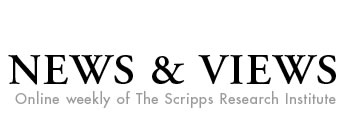

In Brief
SOF Hosts Fall Research Symposium
The Scripps Research Institute's Society of Fellows (SOF) welcomes faculty, staff, and students to this year's Fall Research Symposium, which will be held Thursday, October 4 on the La Jolla campus. SOF symposia provide a venue to learn about the most exciting campus research projects as presented by junior scientists. This fall's presentations encompass topics including chemistry, chemical biology, structural biology, molecular biology, cell biology, immunology, molecular and experimental medicine, and the neurosciences.
In total, 72 abstracts will be presented during an oral session (Keck Amphitheater, 12:40 - 5 PM) and a moderated poster session (Beckman galleria, 5 - 6:30 PM; posters will be available for viewing starting at 10 AM). Presenters in both sessions will compete for cash prizes awarded for best in category.
Additionally, keynote lectures will feature Paul Muchowski of the Gladstone Institute of Neurological Disease and University of California, San Francisco, speaking on "Identifying Disease-Modifying Pathways for Neurodegenerative Diseases Using Yeast Genetics" (Keck Amphitheater, 11:30 AM - 12:30 PM), and Pamela Björkman of the California Institute of Technology/Howard Hughes Medical Institute, speaking on " Fc Receptors: From Molecules to Cells" (Keck Amphitheater, 2:30 - 3:30 PM).
Library Tip: Online Videos for Scientists
It seems like online video sites are everywhere these days. Even CNN got on board with a YouTube election debate. Now scientists are exploring if this medium will further communication in their field.
Here are a few websites to check out:
• SciVee, created by Phil Bourne of University of California, San Diego, is a "YouTube for scientists." Researchers can post a 10-minute video explaining results from a paper they published.
• The Science Network wants to be the C-SPAN for science. Currently, the site has videos from various meetings and symposia such as the Stem Cell Meeting on the Mesa that took place at the Salk Institute, and a talk by Sydney Brenner from the Science Masters series.
• Another site, JoVE, offers videos of scientists explaining their experimental protocols.
For more information, contact the Kresge Library Help Desk, x4-8705 or helplib@scripps.edu.
"Walk n' Roll" to Raise Money and Awareness to Fight Ataxia
In recognition of International Ataxia Awareness Day, the San Diego Support Group of the National Ataxia Foundation invites participants and spectators to The First Annual Charley McLaughlin 2K Walk n' Roll For Ataxia. The event will be held on Saturday, September 29, at Tuna Harbor Park next to downtown San Diego's Fish Market (750 North Harbor Drive), in the shadows of the USS Midway. Free parking is available at the Fish Market. Registration runs from 7 - 8 AM, and the Walk n' Roll starts at 8 AM.
There is no registration fee; donations will be gladly accepted. All proceeds benefit the National Ataxia Foundation, a nonprofit organization established in 1957 to help families affected by hereditary or sporadic ataxia. Ataxia is an often-fatal degenerative neurological disorder that affects the balance, coordination, and speech of more than 150,000 men, women and children in the United States. As the disease progresses, it also can impact heart, sight, and hearing. Ataxia can strike anyone at any time; children, adolescents, and adults are all affected.
Charley McLaughlin, the event's namesake, was a native San Diegan who died earlier this year at age 44 from complications caused by Friedreich's Ataxia. Charley's brother Earl, who also suffers from Friedreich's Ataxia, is a leader of the San Diego Ataxia Support Group.
For more event information, or to volunteer, contact Earl McLaughlin at (619) 447-3753 or sdasg@cox.net. To find out more about ataxia, visit www.ataxia.org. To see how one Scripps Research lab is advancing knowledge about Friedreich's ataxia, see "Team Reverses Friedreich's Ataxia Defect in Cell Culture" and the Gottesfeld lab website.
Cafeteria Art Returns
The Postdoctoral Services Office and the Society of Fellows (SOF) are pleased to announce the return of employee-created artwork to the walls of the cafeteria at 3301 N. Torrey Pines Court, La Jolla. About 10 pieces will be displayed through the New Year, after which time new pieces may be installed. If you are interested in exhibiting pieces you have painted, photographed, sketched, etched, or otherwise created, email Ryan Wheeler, rwheeler@scripps.edu, with a description of your art (medium, approximate size, etc.).
The SOF will sponsor a reception to mingle with the artists on Friday, October 12, at 3 PM, in the cafeteria. No RSVP is necessary .
Upcoming Onsite Clinics
On Monday, September 24, Wednesday, September 26, and Friday, September 28, personnel from Sharp Rees-Stealy Medical Group will be onsite to conduct TB screenings, hepatitis B immunizations, serum draws, and tetanus immunizations.
The clinics will be conducted in the 3366 Building, in Room 325, on the third floor, from 11 AM to 2 PM on Monday, Wednesday, and Friday.
No appointments are necessary. TB screening requires a 48 to 72 hour follow-up. Individuals receiving the TB screen on Monday will need to return on Wednesday, and individuals screened on Wednesday, will need to return on Friday. Initiation of the TB screening process will not be available on Friday, but hepatitis B immunization, serum draws, and tetanus immunizations will be. To learn more about these programs, see the Environmental Health & Safety Occupational Medicine web page.
Send comments to: mikaono[at]scripps.edu
